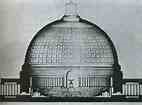On the 2nd page of a Martin Fuller essay in the
New York Review of Books (12/17/15), on the architecture of the Third Reich, I found this image:
 |
| Architect's rendering, the Volkshalle |
It's an architectural drawing for what was intended to be the Volkshalle, the Great Hall of the People, the centerpiece of a project to transform Berlin into a city called "Germania." What I saw, however, was Rome's Pantheon, or some version of it. That's hardly a novel, or even an interesting observation. Almost anyone who has stood inside the ancient Rome building would have a similar perception.
 |
| Rome's Pantheon |
As I was soon to discover, there is, indeed, a connection between Hadrian's Pantheon and the German architect Albert Speer's design for the Volkshalle.
Hitler's interest in the project dates at least to 1925, when he sketched an early idea of what the hall might look like, and it deepened in May 1938, when he toured the Pantheon as part of his only trip to Rome, where he met Mussolini and laid the groundwork for the Axis.
Hitler's admiration for Rome, and its Pantheon, surfaced again in 1940
 |
| Speer and Hitler, examining a model of Germania |
when, with Speer and other German architects, he toured Paris and that city's Pantheon, only to be disappointed. By that point, he imagined that his Germania would "only be comparable with ancient Egypt, Babylon or Rome. What is London," he asked, "what is Paris by comparison?"
Well, Hitler was right about that, anyway. But he and Speer--according to Martin Kitchen's recent book, a pedestrian architect with delusions of grandeur, and an evil man--had conceived of a project that even they couldn't pull off.
The overall plan for Germania included two grand boulevards (Mussolini, too, loved his broad boulevards), each 120 meters wide, lined with triumphal arches and
 |
| Imagining the exterior |
grand buildings, including the Volkshalle.
As with Mussolini's Rome, the reconstruction of Berlin would have required tearing down hundreds of existing buildings and relocating tens of thousands of people. Speer had designed the Volkshalle along stupendous lines. While the interior skin of the dome resembled Rome's Pantheon, the German version was to have been much, much larger: 320 meters high; the podium on which the dome was placed was figured at 315 meters square, roughly the length of 3 football fields; the dome's oculus, at 46 meters in diameter, would, apparently, have been large enough to place inside the entire rotunda of Hadrian's Pantheon. On top would rest an enormous eagle, holding in its claws a ball--the earth. So subtle!
Hitler and Speer, who spent night after night mulling over plans and models of Germania, imagined a building in which Hitler would mesmerize the great throngs: 180,000 people at a time, most of them standing,
 |
| A rally outside |
if the preliminary drawings are an indication. There was also a seating area along the sides, resembling the Congress Hall at Nuremberg--which, according to one source, was modeled on the Coliseum. So large was the interior of the Volkshalle that even Speer, during time spent in prison after the war, speculated that so many bodies (and, therefore, so much humidity) in one great space would produce the dome's own "weather"--drizzle and rain.
Mussolini had grand plans, too, but he had the common sense to position his equivalent of Germania--
EUR--in a largely undeveloped area south of the city center. In contrast, Hitler's Germania was in the heart of Berlin. According to one authority, had it been built, "Berlin's historic center would have forever been destroyed."
The dictators differed on their cities. Mussolini was fond of Rome, and one could argue that his interventions, while hardly minimal and undeniably damaging, were designed to improve the city. Hitler, in contrast, disliked Berlin, most of whose voters had refused to support him in 1932-33. Germania was his revenge.
Of course it wasn't built,
nor was EUR completed until the 1950s. The war intervened. How sad!
Bill






















